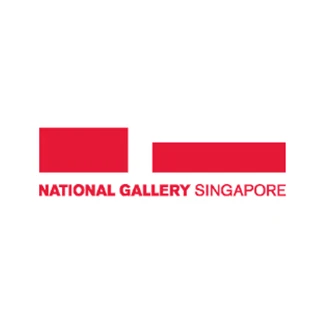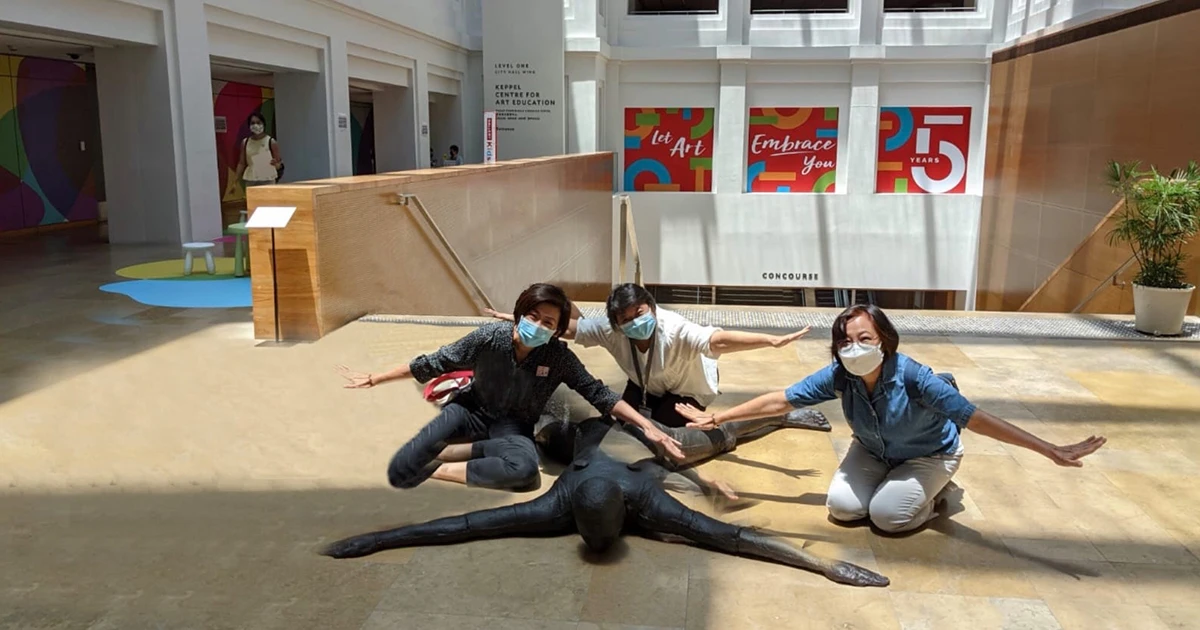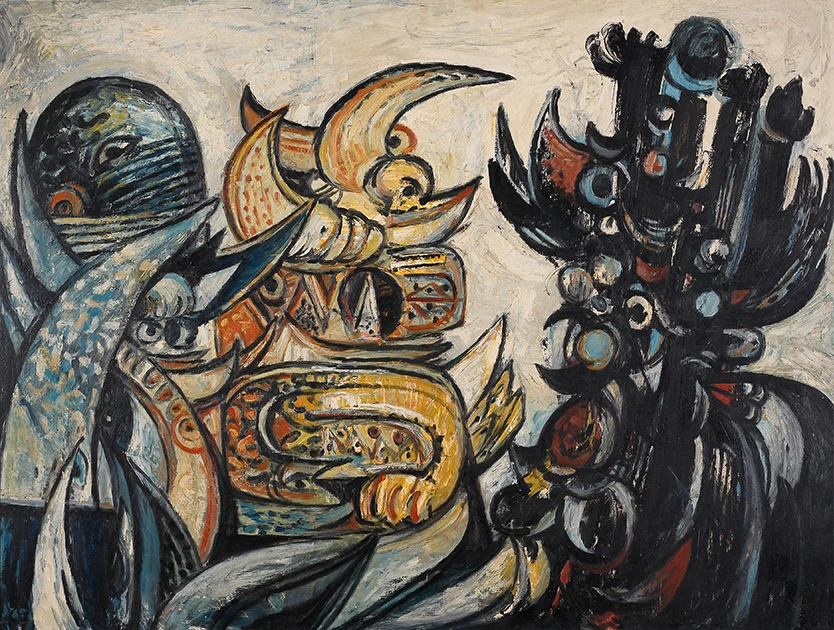Art Therapy and The Care Collection In Conversation with Art Therapist Dian Handayani
National Gallery Singapore and the Singapore Art Museum recently teamed up to develop The Care Collection: Caring through the Arts, a selection of artworks from both museums that can be used for art therapy. For World Mental Health Day on 10 October, the Collection's curators Lim Shujuan, Goh Sze Ying and Clarissa Chikiamco speak to art therapist Dian Handayani to learn about art therapy and how The Care Collection has been received.
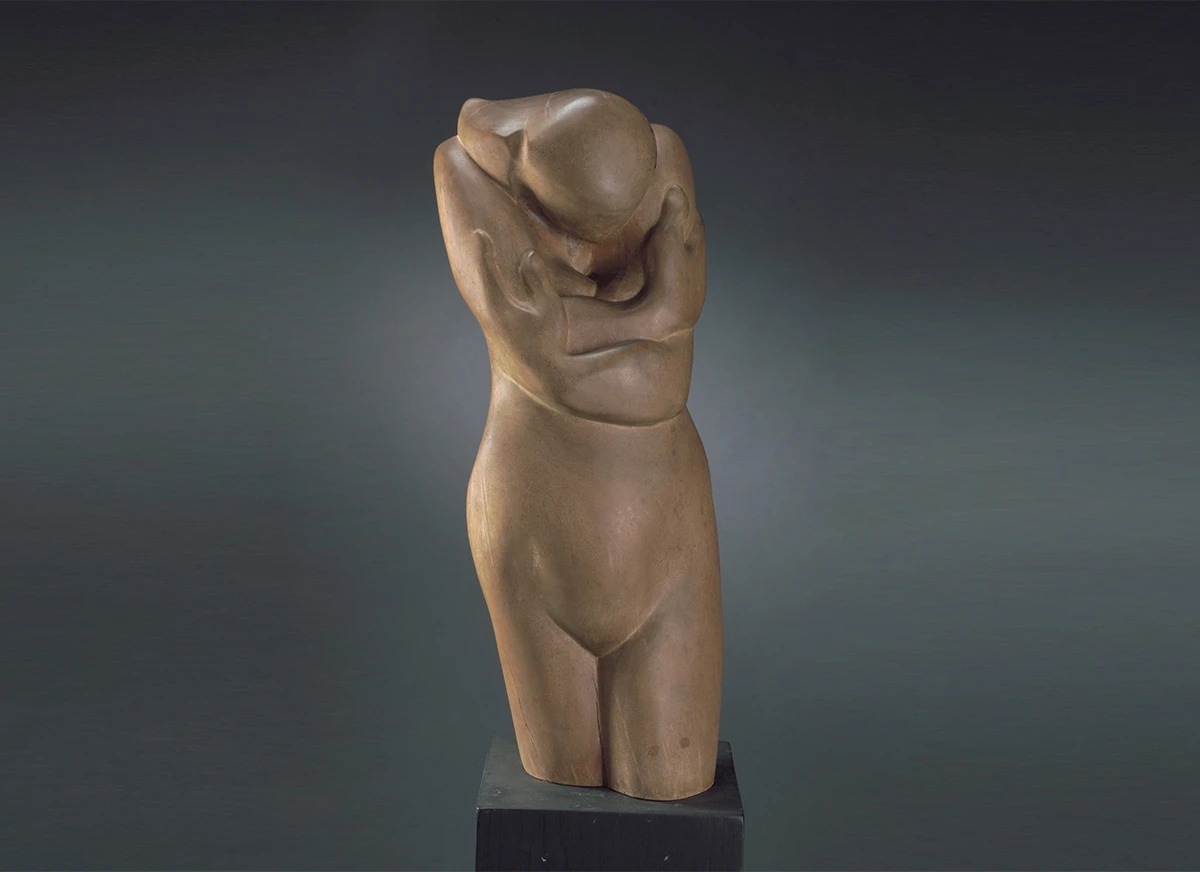
Girl with Folded Arms, 1980
Jambu tree trunk
130 x 27 x 30 cm
Gift of Mobil Oil (S) Pte Ltd
Collection of National Gallery Singapore
Girl with Folded Arms is one of the artworks selected for The Care Collection.
National Gallery Singapore and Singapore Art Museum recently teamed up to develop The Care Collection: Caring through the Arts. The Care Collection draws from the collection of both museums to provide a selection of artworks based on seven themes—courage, connection/disconnection, resilience, hope, growth, self-love/self-compassion and being in the present.
The curators of The Care Collection for National Gallery Singapore—Lim Shujuan, Goh Sze Ying and Clarissa Chikiamco—interviewed art therapist Dian Handayani from Singapore General Hospital (SGH) through a live video call to learn more about art therapy and the reception of The Care Collection. Dian is the leader of the SingHealth iTHRIVE ARTpreciate programme, which has been using the artworks from the collection to conduct regular art therapy sessions for SingHealth healthcare workers and staff since June 2020.
This interview has been edited for brevity and clarity.
Shujuan: How would you define art therapy? Is looking at art or making art considered art therapy and how does it differ from going to a gallery to look at art?
Dian: I see art therapy falling between two spectrums—art as therapy and art psychotherapy. As art therapists, we are trained to do both. We all know that art has healing properties—even making art can be very healing, very soothing for the mind. At the same time, we also have training in psychology, psychotherapy, human development, and counselling. In my therapy session with patients, I combine both, or I move from one end to the other depending on what they need. Also, it depends on my assessment of the patient and the goal of the therapy. So those are the basics of art therapy.
Now the difference between art therapy or art in healthcare and just viewing art, is that art therapists are trained to be able to build a certain kind of relationship with the patient. It is called a therapeutic relationship or therapeutic alliance. It’s a very important ingredient of therapy because without that therapeutic alliance, it would be very difficult for the patient to trust us. And the benefit of therapeutic alliance is when they trust us, they're able to express how they feel. Sometimes throughout the sessions, if we the therapists feel that we need to gently challenge the patients in the right direction, we can use that relationship to challenge them, to help them achieve the goals that they intend to achieve in the first place.
Sze: I'm curious: how does art therapy differ from other types of therapy?
Dian: I guess the biggest difference is art therapy uses creative means. We use artmaking as our main mode to engage with our patients to express their struggles and difficulties. Typically, the other kind of therapy is verbal talk therapy, which addresses issues through verbal means and it’s a very cognitive thing. But with art therapy or even music or other kinds of expressive therapy, we can really get into the patients’ issues another way.
I’ll give you an example. I have a patient who has difficulties expressing a certain situation. After several attempts to try to verbally describe the feelings around the situation, my patient still couldn’t find the “right expression – it just doesn’t feel right!” I suggested her to pause for a while and asked: “Where does “doesn't feel right” come in?” The patient replied, “You know… the heart still doesn't feel right.” I had art materials and suggested the following, “If the heart could have a colour, what would that colour be?” The patient said, “Oh, it feels more like a reddish black.” “Okay, take those colours and allow the colour to take a shape”.
Subsequently I then asked, “If this colour/ shape had movement, what movement would that be?” Eventually the patient formed an image that looked something like a lump and he said, “Yeah, this is it! With a heavy heart.” Thereafter we can process the meaning behind the expression and it turns out that the patient was struggling with difficult grief and loss. That’s the beauty of using art therapy. It opens another door and path towards healing and integration. I like a quote by (I think) Babette Rothschild, a trauma specialist. She said, “To name it is to tame it.” Because if you don't know what's going on, how can you tame it?

Sze: So the visuals cue the patient to speak more or to be able to articulate their feelings. My follow up question to that would be how do you assess the benefits of art therapy in contrast to a psychology session that involves more talking?
Dian: The benefits of art therapy can be experienced by the patients and subsequently their loved ones too. In the context of my work, where I work together with doctors, nurses and other allied health professionals, we noticed that patients are much better at articulating their issues and needs when art therapy is introduced. A psychologist colleague once shared that art therapy has helped her patient to find a break-through in their issues. As such, art therapy sessions augment and enrich the patient’s experience and enhances their recovery.
Clarissa: How did you come to be involved in art therapy?
Dian: I was a designer before. I did a bachelor’s degree in industrial design and then I did work in design for a while. Then when I moved to Singapore, I couldn't find anything fulfilling and I guess I was kind of tired of design. [laughs] I still love design. I'm just tired of the industry. [laughs] It's no longer meaningful for me.
I remember reading the newspaper and it advertised the LASALLE Open House for Art Therapy. On that night I immediately said, “Let's just go to their open house.” I talked to a couple of students there and I really loved it. And then I just closed my eyes and signed up. That was in 2008. I studied there for two years and then when I graduated, SGH had an opening. They were looking for someone to conduct art therapy for those with eating disorders. I applied and have stayed on since then. This is my tenth year here.
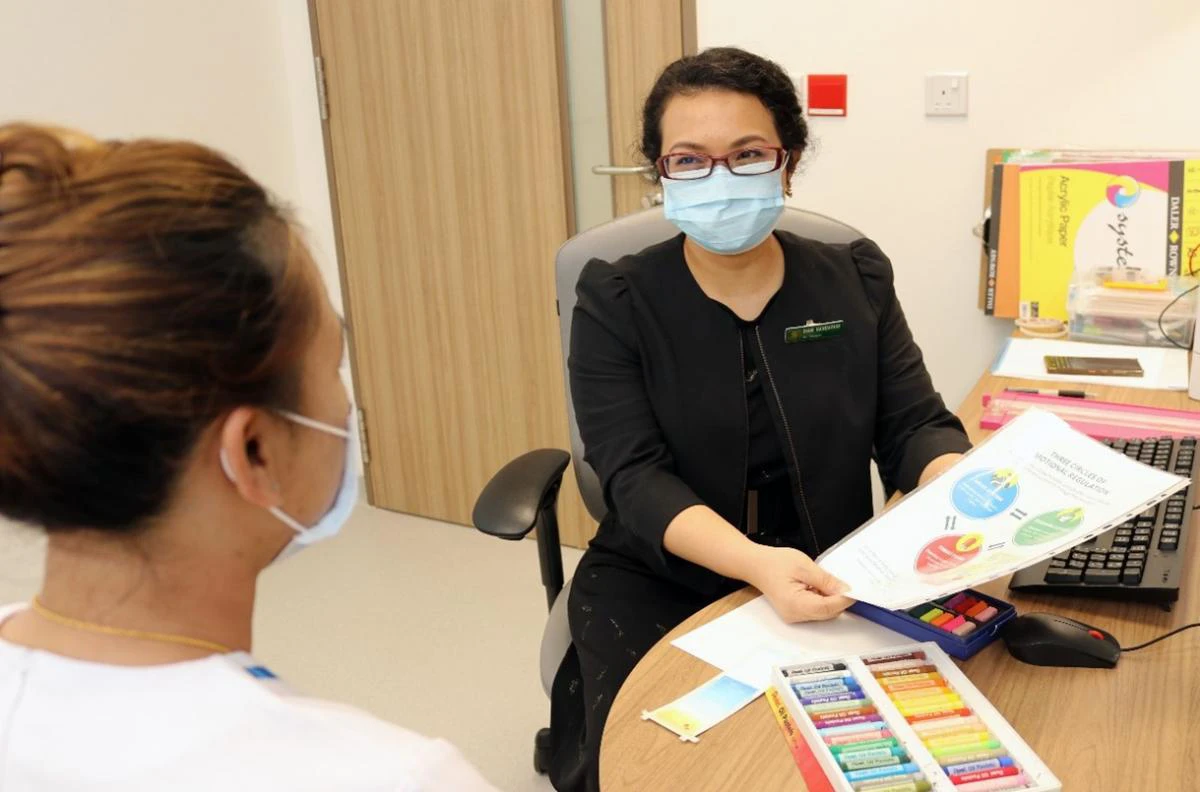
Clarissa: Could you describe your job as an art therapist at SGH? What is a typical day like for you?
Dian: A typical day is varied, it depends on the patient load. Like today, there was a referral for me to see a patient that wasn't planned. So it's quite fun actually. No one day is the same.
Clarissa: So typically patients are referred to you and they don't just go directly to you?
Dian: That’s right. We don't receive private referrals. We only receive referrals from the doctors at SGH.
Shujuan: Could you describe the kinds of artworks you use in art therapy sessions?
Dian: Art therapy is very patient or client-centred. I always prepare a variety of materials but the patient decides what materials they want to use for the session. So, I won't know actually beforehand.
Sometimes I have patients who like painting because it helps with their emotions but there might be days when they want to use clay. There are times where they just pound and pull apart the clay. There are days where they make nothing and we just talk for a while. What I'm trying to say is that art therapy is more focused on the process, which is very different from the museum. For museums, you must have the final artwork, right? For art therapy, it is really about the process of artmaking and how that process can help our clients express themselves.
Shujuan: In the process of art therapy, how do you evaluate if it is more valuable for a patient to look at an artwork to express their feelings or create an artwork?
Dian: I would like to use the metaphor of a dance. When you are in the room with your patient, you're really trying to tune in to what they need. There are times when the patient is like, “You know, I really can't make art today. I just can't. Can we just talk?” And of course, I will follow their lead. Let's just talk.
But there are times where I will nudge them to engage in art through viewing art, for example. I’ll then suggest that we look at different images to see if anything speaks to them. I collect these magazine cut-outs which I use for collage-making. My patients know that if they are really stuck, they can ask for my box of magazines. We go through the box of magazines, and they are usually able to find an image that resonates with them, like “You know that picture over there, that person slumping on the table? That is definitely how I feel right now.” And then we’re able to kind of talk about how they feel. They can also create a collage.
There are patients who come to me and say, “Look, I saw this picture in the magazine or I saw this picture in the museum. Remember the last time I told you about X, Y and Z. This is it. This is exactly how I feel. This is exactly what my struggle is.”
So—it's like a dance, really. It depends what the patient needs.
Now there’s a stark difference between one to one sessions like I mentioned above and a group session like ARTpreciate. For example, with the ARTpreciate sessions, the main goal is to create a group for healthcare workers focused on mental well-being. This goal is articulated and expressed through The Care Collection. The Care Collection is meant to inspire well-being for the group, which is different from working with a patient one-to-one. There’s an objective and purpose in mind. I really hope that the artwork images and the accompanying script can help with that.
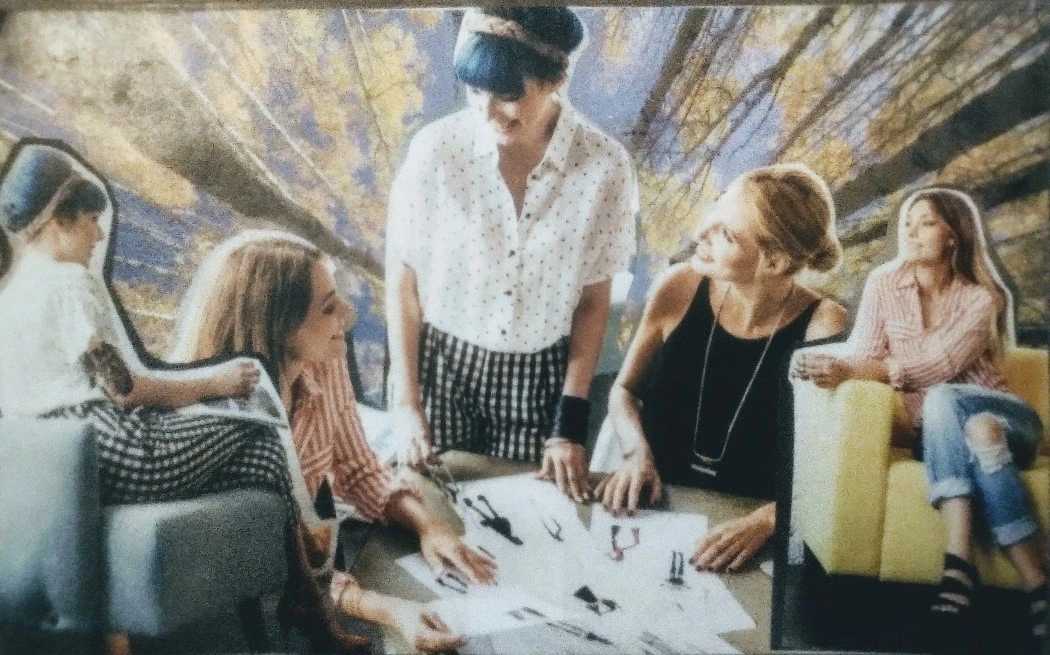
Sze: Could you tell us what sparked the idea of using artworks from the National Collection to offer sessions to the staff?
Dian: It came from my own experience. I was so ill at the beginning of this year; I don't know what happened to my body. I was out of work for about a month. It was not nice. So what do you do as an art therapist who is sick? After endless Netflix, I said to myself, you call yourself an art therapist, let's go back to artmaking. I like making collages. I collect magazines so I make collages with this technique called SoulCollage. SoulCollaging helped me understand what I was going through during that difficult time. That helped me and so as I was cutting away, I thought it would be good to share this technique. But not everyone is a hoarder who keeps magazines like me. So what can I do? I thought: who has the most plentiful images in the nation? Of course, National Gallery and Singapore Art Museum.
Sze: Wow, thanks. That’s actually brilliant.
Dian: Yeah, I thought they would have a lot of images and that's what got me excited. And I said when I get better I will try to contact them. So I contacted Max [Cheng] from National Art Council and Max put me in touch with Alicia [Teng, Assistant Director, Community and Access, National Gallery Singapore] and Sharon [Chen, Senior Manager, Education and Programmes, Singapore Art Museum]. And then the rest is history. So that was inspired by the time when I was really sick and I could only turn to art for a healing experience.
Sze: Since you've been using The Care Collection, how has it been received? Could you share some comments or feedback.
Dian: It's really interesting. As I'm running the programme, one of the most enjoyable things has been feeling joy. It’s really nice because I hear people say, oh wow, this reminds me of my childhood; having that moment to reminisce. I just couldn’t stop smiling—"This gives me a sense of peace; this gives me a sense of hope.” I find that very inspiring.
Sze: That’s very heartening to hear.
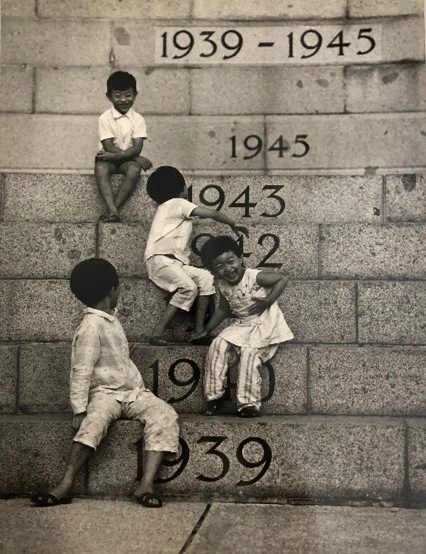
Dian: This is the photograph I was referring to earlier. There are kids on the steps. Even when I was writing the script and mindfully looking at this picture, I could feel myself smiling. People really enjoy looking at this image, and I tell them to make it an intention to spend time with your family or your loved ones.
Clarissa: In line with that, are there forms of art therapy that people can do on their own to care for themselves without having to engage in a formal session? Are there any particular exercises you recommend for people to do regularly for their mental health or mental well-being?
Dian: What makes it art therapy is the therapeutic relationship, so you still need a therapist. That's what makes art therapy different. But of course, artmaking itself is therapeutic. So I tell my clients to consider art journaling, which some find very therapeutic. Or Zentangle. Any artmaking exercise that is repetitive and follows a certain pattern can be quite soothing. There's also Nagomi Pastel Art which is quite nice and soothing because of its sensory element. You create a soft pastel like this. I'm a certified instructor for this as well.
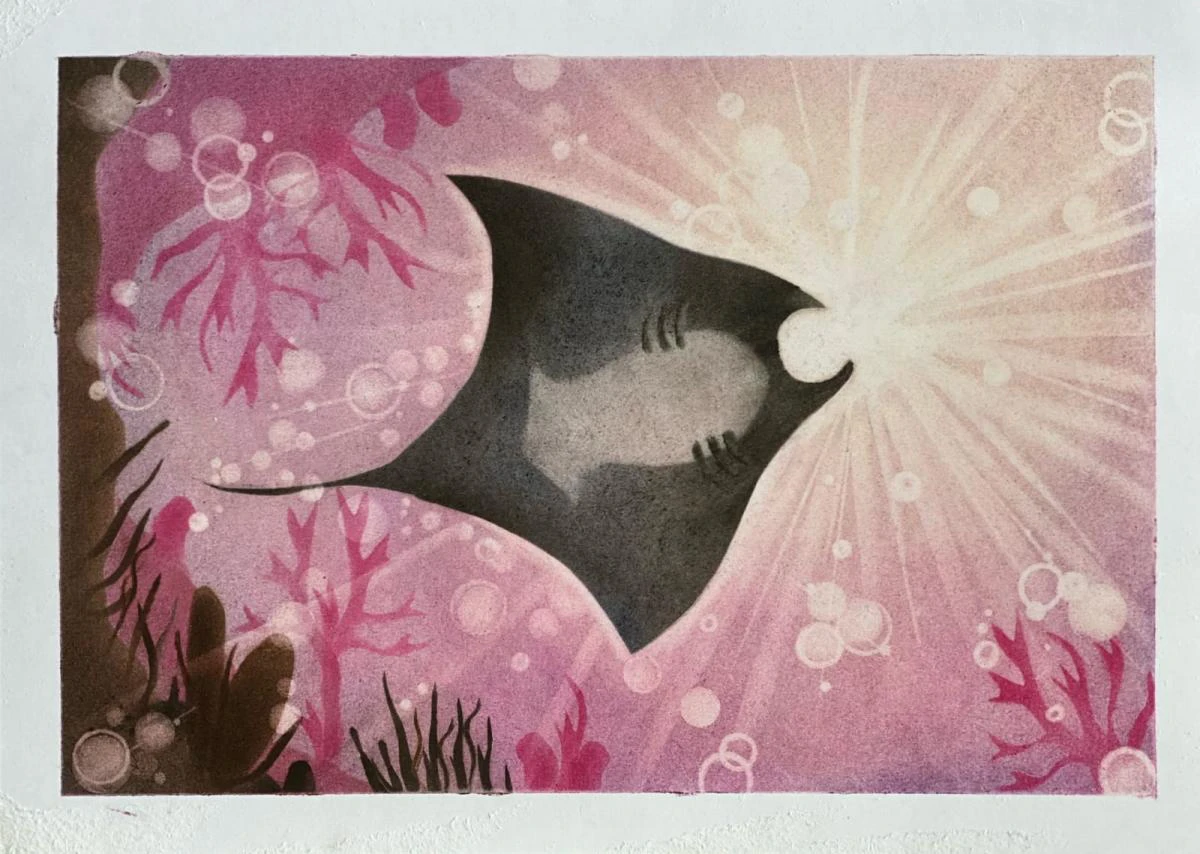
With this pastel you make a powder out of it and then you blend it with your finger so it's very sensory and can be very soothing. It’s a Japanese technique. Colouring is also very popular, isn't it? Anything that is kind of repetitive is really good. There’s research that says 45 minutes of artmaking, even if you think you are really bad at it, can reduce your stress hormone.
Clarissa: Thanks so much, Dian. We learned a lot hearing from you today.
Dian: Thank you so much for all the help with your collection as well. I just want to say how privileged I feel to see images of these artworks all the time, some of which are not even on display. So I treasure these artworks.
Sze: The feeling is mutual, Dian. We are really pleased that the collection can be used or extended to such a different way of looking or appreciating art. You're doing us a great service.
Editor’s Note: If you would like to use The Care Collection: Caring through the Arts for art therapy or your community’s needs, contact National Gallery Singapore’s Community & Access team at community@nationalgallery.sg.









-min 1.png)
